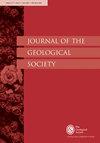化合地层学和近缘趋势在威尔士西南部志留纪珊瑚岩层中的应用:古海岸线横断期间的有节奏沉积作用
IF 2.6
3区 地球科学
Q2 GEOSCIENCES, MULTIDISCIPLINARY
引用次数: 0
摘要
彭布鲁克郡志留纪珊瑚岩层由沉积于英国威尔士盆地南缘的 94-143 米陆架沉积物组成。该层系以裸岩(伦尼滑坡层)开始,上覆夹层淤泥质泥岩和砂岩(死人湾层)。两个主要部分(Renney Slip 和 Marloes Sands)之间的生物地层学控制较弱,但高分辨率化学地层学可区分出 11 个分支。一些化合地层单元可以在各断面之间进行追踪,而其他单元则在局部地区不存在。化合地层单元的相关性与海平面周期进行了比较,海平面周期是通过对风暴床的频率、分布和特征的研究,利用近似趋势分析法确定的。这表明死人湾成员内可追溯的化学地层单元具有同步性,表明沉积始于伦尼滑坡段,并且那里的水深更大。整体评估显示,珊瑚岩层覆盖了一个不整合面,古沉积厚度为 57 米,距今 3 千米。对底栖动物群落、沉降速度和全球海平面波动的进一步研究表明,泰利希斯晚期的横断面存在,冰川作用导致海平面上升了 40 至 70 米。本文章由计算机程序翻译,如有差异,请以英文原文为准。
The application of chemostratigraphy and proximality trends to the Silurian Coralliferous Formation of SW Wales: rhythmical sedimentation during the transgression of a palaeo-shoreline
The Silurian Coralliferous Formation of Pembrokeshire comprises 94–143 m of shelfal sediments deposited on the southern margin of the Welsh Basin, UK. The succession begins with rudites (Renney Slip Member), which are overlain by interbedded silty mudstone and sandstone (Deadman's Bay Member). Biostratigraphical control is weak between the two principal sections (Renney Slip and Marloes Sands), but high-resolution chemostratigraphy permits 11 subdivisions to be distinguished. Some chemostratigraphical units can be traced between the sections, whereas others are locally absent. The correlation of the chemostratigraphical units has been compared with sea-level cycles identified by a study of the frequency, distribution and characteristics of storm-beds using proximality trend analysis. This suggests a synchroneity of traceable chemostratigraphical units within the Deadman's Bay Member, indicating that deposition began in the Renney Slip Section, and that a greater water depth was achieved there. A holistic assessment shows that the Coralliferous Formation onlaps an unconformity surface with a palaeo-relief of 57 m, over a current distance of 3 km. Further considerations of benthic assemblages, subsidence rates and global sea-level fluctuations support the presence of a late Telychian transgression with glacio-eustasy contributing between 40 and 70 m to that sea-level rise.
求助全文
通过发布文献求助,成功后即可免费获取论文全文。
去求助
来源期刊

Journal of the Geological Society
地学-地球科学综合
CiteScore
6.00
自引率
3.70%
发文量
68
审稿时长
6-12 weeks
期刊介绍:
Journal of the Geological Society (JGS) is owned and published by the Geological Society of London.
JGS publishes topical, high-quality recent research across the full range of Earth Sciences. Papers are interdisciplinary in nature and emphasize the development of an understanding of fundamental geological processes. Broad interest articles that refer to regional studies, but which extend beyond their geographical context are also welcomed.
Each year JGS presents the ‘JGS Early Career Award'' for papers published in the journal, which rewards the writing of well-written, exciting papers from early career geologists.
The journal publishes research and invited review articles, discussion papers and thematic sets.
 求助内容:
求助内容: 应助结果提醒方式:
应助结果提醒方式:


